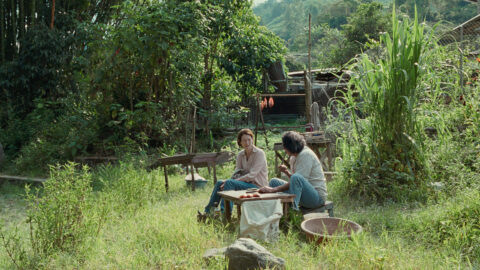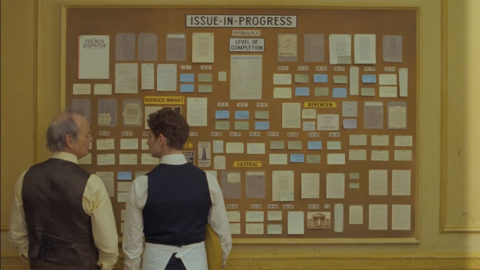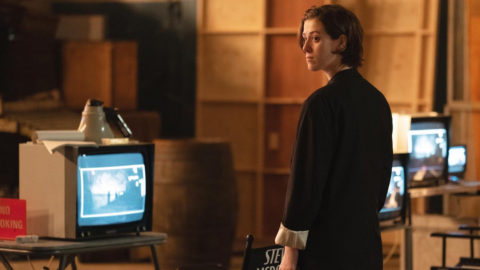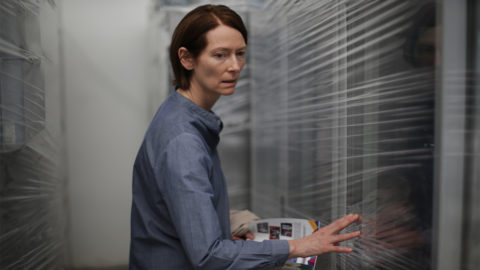Cannes Interview: Miguel Gomes & Maureen Fazendeiro
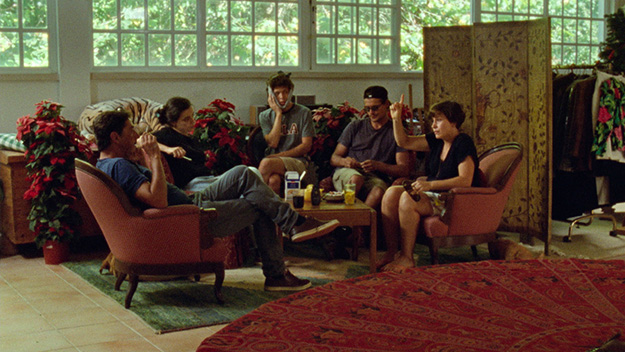
The Tsugua Diaries (Miguel Gomes and Maureen Fazendeiro, 2021)
This article appeared in the July 22 edition of The Film Comment Letter, our free weekly newsletter featuring original film criticism and writing. Sign up for the Letter here.
While for most of us the pandemic put best-laid plans to rest, some found in it the opportunity to pursue new and unexpected avenues. For Miguel Gomes and Maureen Fazendeiro, the 2020 lockdown forced the Lisbon-based filmmakers and life partners to set aside work on Savagery, their long-awaited adaptation of Euclides da Cunha’s 19th-century-set wartime novel Os Sertões, and instead embark on an experiment that could parlay the global health crisis into something uniquely contemporary, collaborative, and cinematic. The result is The Tsugua Diaries, a playfully constructed account of pandemic life featuring Carloto Cotta, Crista Alfaiate, and João Nunes Monteiro as a trio of friends and possible lovers who, as the film unfolds in reverse chronology, are revealed to be actors making a film very much like the one transpiring onscreen.
Set in and around a provincial farmhouse outside Lisbon, the film slyly charts the plight of the cast and crew as they deal with the restrictions and health measures required of a COVID-era production—although, what emerges is less a parable of artistic stagnation (in the vein of, say, Truffaut’s Day for Night) than a chronicle of creative renewal by other means. As co-directors, Gomes and Fazendeiro, who appear in the film as themselves, allowed the project to take shape organically, integrating and reimagining real-life details—such as Fazendeiro’s pregnancy and the presence of an abandoned hummingbird cage—as they went along, ultimately bringing the film full circle by working backwards through its own development. As both a mirror of its making and an echo of Gomes’s prior forays into a hybrid cinema—most notably Our Beloved Month of August (2008), which is invoked here on more than one occasion—The Tsugua Diaries is the rare pandemic film that turns the limitations of its concept into a productive path away from traditional storytelling models.
Following The Tsugua Diaries’s premiere in this year’s Directors’ Fortnight, I met up with Gomes and Fazendeiro on the beach in Cannes to discuss the film’s evolution, constructing the narrative through improvisation, and how this “anti-lockdown diary” doubles as a celebration of filming people, trees, and objects.
How did you two first come to work together? Maureen, you were the casting director on Arabian Nights, right?
Maureen Fazendeiro: Yes. We first met in 2012, when I was working for a publishing house in France, and we made a book about Miguel’s film Tabu (2012). Then, when Miguel was shooting Arabian Nights (2015), he invited me to be the casting director for the French portion, that is the Scheherazade story, which was shot in Marseille. He asked me to find the 100 virgins.
Miguel Gomes: And then the producer cut it to 50.
MF: [Laughs] Right. Then I moved from France to Portugal, and a year later he asked me to marry him, and I said yes.
If I remember correctly, the proposal happened here in Cannes, right?
MG: During the Arabian Nights party. At 3:00am!
MF: Not long after this Miguel started to think about a new film, Savagery, which is an adaptation of a Brazilian book about the war. Along with Mariana Ricardo and Telmo Churro, we started to write this script three years ago, I think.
MG: In 2016.
MF: Right. Since then we’ve written several projects together, but all of them, including ones we are working on individually, stopped because of the pandemic.
That more or less brings us to The Tsugua Diaries, which you shot in August and September of 2020. At what point did you guys think of taking up a project during the lockdown?
MG: I don’t think I’ve said this to anyone because I’m just now recalling it, but I think the first time it occurred to me was while I was talking with the director João Pedro Rodrigues at the Portuguese directors guild. I think this was in April 2020, and João Pedro was saying, “What can we even do nowadays? It’s impossible to shoot a film right now, except maybe if it’s a documentary about the COVID situation.” As he said this, I started thinking, yeah, maybe we should come up with a way to make a film, like he says, about the situation, but also about other things.
During the initial lockdown it was still possible to go out to see friends, so we went to Crista Alfaiate, the actress in the film. We just discussed the situation with her, and how difficult it was for our colleagues in theater because they weren’t receiving much support from the government. We were a little bit angry with that. So we started to think, “OK, why not make a film? Let’s get COVID tests and let’s go to a place where we can live and make a film together.” The location ended up being both a studio and our house. We didn’t have time to write the script, but we had to convince the producers to give us some money to make the film.
MF: Which was actually very easy. We had no idea what we were going to do. We just told them we want to make a film, and they said, “That’s a great idea, let’s go.” [Laughs]
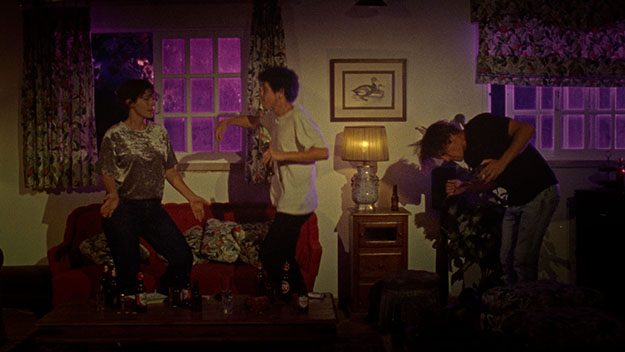
The Tsugua Diaries (Miguel Gomes and Maureen Fazendeiro, 2021)
How did the writing process take shape when you finally arrived at the house? What was the initial idea as it was proposed to the actors?
MG: In the weeks before entering the house we gathered two or three ideas. One was to do it in the form of a diary. Another was to tell the story in reverse chronology. Then we chose three actors and a crew. We didn’t know much more than this. Oh, and we also wanted to have a kissing scene. We chose two men and one woman to act in the film, so the woman would give a kiss to one of the men. It was this moment that prompted the intervention of a health official—for this kissing scene, which is completely trivial.
Similar to what we see in the film?
MF: Yes, like that. There were rules for the actors to even be around each other.
MG: We ended up shooting the kiss on the last day, but because of the reverse chronology we were able to say that it would be shot at the beginning of the shoot, when the risk was quite low and we weren’t leaving the house much. This was not completely true but that was the idea. We had this white board where we kept track of the chronology. There was never a script—just ideas for scenes. We were erasing and adding new scenes sometimes but we had the structure to keep things in order and to understand how the film functioned backwards and then forwards.
MF: The first week in the house we spent with Mariana Ricardo, our co-screenwriter. She’s worked with Miguel for a long time. We never actually wrote, but we had the white board, and the first week was really to explore the house, because a lot of things in the film came from the house, what was already there. Then the second week the actors came and we improvised with them. Then the crew arrived and we had four weeks to shoot, and every day we reorganized the structure according to what was happening that day.
At what point did you start to integrate yourselves and the COVID-19 situation into the film? Were the self-referential aspects all there from the beginning?
MG: In the structure we wrote during this first week we were also designing a movement for the film. And this movement would start closer to the conventional idea of cinema: people dancing, a kiss, and then the film would start to open up. We would start to understand that these guys are not alone, that they are making a film, and that they are actors. The film goes from this clichéd idea of cinema to a life movement. We had this written on the board. At one point the film was even called The Pure Life, but it was not the right title. Maureen told me it sounds like a wellness brand, which is no good. [Laughs] It was through this process that we discovered that the film is, of course, a portrait of this moment, of the lockdown and everything, the pandemic, but also about people sharing things together, living together, working together.
Tell me about the house.
MF: It’s one of our producers’ uncle’s house. It’s a family house. They’ve had it for many years. It used to be a farm for raising chickens. So part of the house was full of cages, which is strange when you’re in lockdown and want to make a film about that moment. The other part was transformed into a ballroom, something for weddings or things like that. It was not easy to find a house that could also be a studio for a crew of 16 people. You need a big house. Our producer said, “I have this house, but it’s very strange. I’m not sure you will like it.”
MG: It’s like a storehouse for family heirlooms.
MF: When Carloto and João are looking for the dog, there’s this long shot of them going through several rooms, and you see what we called “the intestine” of the house.
MG: It’s the film’s The Shining moment. [Laughs]
How did you decide on the actors? Of course, you’ve worked with Carloto before.
MG: And Crista is in Arabian Nights, but this was the first time I’ve worked with João. Crista was involved from the beginning because it was with her that we decided to make the film. She was there even before the house. Also, her boyfriend is a theater designer, so we decided we should use both of them and invented a role for him.
MF: He turned into the lighting designer. He had all these colored lights from his work in the theater that we ended up using. We didn’t have much room in the house, but since he could share the same bed as Crista, we said, “We’ll find something for you to do.” [Laughs]
So everyone got a COVID test and moved in together?
MF: Yep, for five weeks.
Miguel, can you talk a bit about the film’s relationship to Our Beloved Month of August? There’s at least one direct reference to it, and the two share similar themes. Also, the title…
MG: I didn’t think about the connections at first. It was only when we were shooting some scenes that I recognized it. For instance, the discussion about breakfast with the sound guy near the end of the film: in Our Beloved Month of August there’s a similar intervention in the last sequence. I included it because like many things—really, almost everything that’s in the film—it really happened. The day Maureen and I explained to the crew how the film would work, what the rules would be for shooting, I asked, “Do you have questions?” And the sound man, Vasco, started to talk about breakfast. It’s a very silly discussion, but at the same time it was a very political and philosophical discussion because he wanted to have a collective breakfast, with the same food for all. But our assistant director said, “No, no, no. Each one of us will have a personal breakfast.” It was like two visions of society, so we immediately put it on the board: “Vasco will discuss breakfast in the film.”
MF: The film Tsugua actually reminds me of most is Miguel’s first, The Face You Deserve (2004). In that film people walk around a house, one of them is sick, and that person disappears, just like it happened to me in the shooting of this film.
MG: The difference that you see from Our Beloved Month of August is that we are now all much older. It was a different time. Our Beloved Month of August was about the pleasure of moving from one village to the other. It was about movement. Here we were enclosed. I think [The Tsugua Diaries] leaves you with this tension between still having this great joy of filming people, trees, and objects, and the joy of being alive, which is a very underestimated subject of cinema nowadays. If you think about Jean Renoir films, it was in every one of them, this tension between joy, living together, making films together. We experienced that here, while at the same time we were locked inside the house.
MF: Like the butterfly cage, the house is both a shelter and a cage.
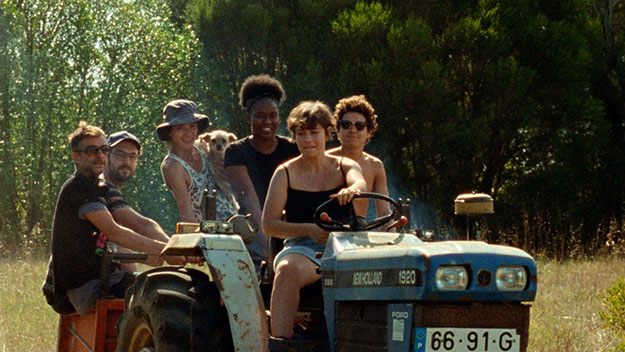
The Tsugua Diaries (Miguel Gomes and Maureen Fazendeiro, 2021)
As we can see in the film, Maureen, you were pregnant during the shoot. Did you have to also work remotely for part of the production, as we see you doing in some scenes?
MF: Yeah, that really happened. I was in the house, but I was stuck on the sofa. I couldn’t move. That whole setup you see, with the monitor, the sound equipment, the walkie-talkies: that’s how we worked on the second part of the shoot. For the first part I was moving around, and the rest was done from the couch. That was one of the things that prompted us to start integrating these real situations into the film.
Can you talk about the film’s relationship to literature? Cesare Pavese is referenced in the film, and a friend of mine compared the structure to Harold Pinter’s Betrayal.
MG: We’re both in different ways inspired by books. I haven’t read this Harold Pinter book but there are other cases of reverse chronology in literature. Nabokov did it. Martin Amis did it.
MF: There’s not as much Pavese in it as I originally conceived. In the end we focused on one word from Pavese.
MG: One word?
MF: Yes.
MG: What’s the word?
MF: Dancing. [Both laugh]
Is that where the idea came from to begin and end the film with dance scenes?
MF: No, we picked it for the dialogue when one of them says, “We miss dancing here.” We had the idea quite early to start and finish with the dancing scenes.
MG: It was a reaction to the moment of everyone being isolated. So on the one hand it’s a lockdown film and diary film, but on the other it’s an anti-lockdown diary, a reaction to all these films shot on cellular phones, which I respect but for me are a little bit boring. We wanted to do the opposite.
Last thing: How is Savagery coming along? Are you allowed to shoot yet?
MF: We can shoot. But it always depends on what will happen, if things are open, if people can travel freely. I’m starting shooting on my own film in September, an archeological movie about a region of Portugal.
MG: There are lots of people involved in Savagery because it’s a war film, and there are a lot of rules for shooting in Brazil because the pandemic is uncontrolled there. They have this criminal president. The rules are that you are not allowed to have more than 15 people between crew and actors and extras on set at any time.
We had to renegotiate some of the funding for the film. But they understood the situation because it’s impossible. I’m also doing another film called Grand Tour that I started just before the virus spread. It’s set in Asia, where we did some shooting already. We traveled to several countries in Asia in January and February, but then we had to stop because we were shooting near Wuhan. Obviously that was not possible, so we came back. It’ll be partially shot in Asia and partially in a studio.
You co-wrote that one together too, correct?
MF: Yes.
MG: It’s a strange… I was about to say it’s a strange love story.
MF: It’s a beautiful love story.
MG: You think it’s a beautiful love story? I don’t know. Let’s make it first and then we’ll see if it’s a love story.
Jordan Cronk is a film critic and founder of the Acropolis Cinema screening series in Los Angeles. His writing has appeared in Artforum, Cinema Scope, frieze, the Los Angeles Review of Books, Sight & Sound, and more. He is a member of the Los Angeles Film Critics Association.



